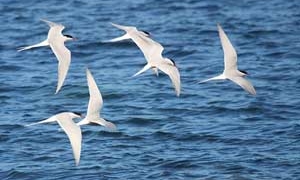Have you ever wondered why migratory birds don’t just stay in the South but instead “fly back and forth” every year?
According to the Audubon Society, there are currently at least 4,000 species of migratory birds worldwide, accounting for about 40% of all bird species on the planet. Although humans have documented the migration patterns of many bird species from the North to the South for at least 3,000 years, there is still much we do not fully understand about this fascinating behavior.
Some of the most notable migratory birds include cranes, doves, and swallows. Additionally, the Arctic Tern is famously known as a “biological airplane” for its ability to fly from the Arctic to the Antarctic during the winter in the Northern Hemisphere, where it also breeds. With this capability, they can experience up to two summers each year.

Migratory birds account for about 40% of all bird species on the planet.
Why do birds migrate from the North to the South?
Contrary to previous beliefs, birds do not migrate to escape the cold. If we look at the Arctic Tern as an example, we see that their destination is the Antarctic, which is just as cold, if not colder, than the Arctic. Thus, the idea that birds need to escape the cold in winter is outdated.
From an evolutionary perspective, all organisms develop behaviors to adapt to their living conditions and optimize energy usage. The question here is, why do migratory birds “invest” a tremendous amount of energy to fly tens of thousands of kilometers back and forth between the North and South each year? Why don’t they settle permanently in a location with abundant food and favorable survival conditions?

Some birds simply migrate to warm tropical areas.
Food, energy, and reproduction are the keys that scientists are relying on to decode this fascinating behavior in birds.
Firstly, it is a fact that winters in the Northern Hemisphere are generally quite harsh. It takes a lot of energy to stay warm, and food is particularly hard to find, especially when fruits, insects, and other invertebrates are predominant in their “menu.”
Moreover, due to the tilt of the Earth, there is a seasonal contrast between the Northern and Southern Hemispheres—in winter in the Northern Hemisphere, it is summer in the Southern Hemisphere, a warm season with an abundance of food. Some bird species simply migrate to warm tropical areas. Once they reach these southern “stopovers,” they can enjoy a rich and plentiful food source without expending too much energy to keep warm.

Two Arctic Terns.
At this point, the answer begins to clarify. There is a clear reason for them to undertake such a long round-trip journey year-round, facing countless dangers (such as being hunted by humans) along the way. While many animal species do not choose to do this, partly because they cannot migrate as far, this is a survival strategy for migratory birds.
“Struggling” to fly back and forth, but it’s worth it!
But why don’t they stay in the tropics year-round where it is warm and food is abundant? It turns out that despite what Hollywood films or songs portray, life in the tropics is not necessarily a paradise. First, while the tropics offer abundant food, the number of hungry predators is equally high.
Migratory birds, being newcomers from afar, must directly compete with these native species. Moreover, the tropical environment is a perfect “incubator” for infectious diseases and parasites.

The tropics have a vast number of native bird species.
To face the “dilemma”: the North is cold and barren, while the South is fiercely competitive and poses health risks, they must develop a perfect strategy. Spring migratory birds have excelled at this, timing their return to coincide with the arrival of spring in the North—the peak time for food, fruits, and insects—to breed. They capitalize on this period for reproductive activities.
Some additional advantages include:
- 1. When they return, predator populations such as foxes or bird-hunting species have decreased due to the harsh winter, allowing them to enjoy a safe and bountiful breeding season.
- 2. Spring and summer in the Northern Hemisphere have significantly longer days compared to nights, giving birds more time to forage and care for their young. The further north they go, the greater this difference becomes—at the North Pole, the sun does not set for weeks.
If they stayed in the tropics, this advantage would be nullified, resulting in fewer offspring.
In summary, the migration of bird species is a complex equation with numerous variables to solve, and through the marvels of evolution over millions of years, they have developed the most optimal strategies for this “investment” of energy and the ability to sustain their lineage. They must answer countless questions: Is this journey worth it? What are the risks involved? What predators are present at the destination? What diseases might they encounter? What species will they have to compete with (including humans)?

Swallows – the “messengers” of spring.
With such a complex “equation,” it is easy to understand that migratory birds are perhaps smarter than we think. The issue is, climate change is likely having a significant impact on these variables, altering their behavior.
Scientists have found evidence of these changes. According to results from 2010, red-throated loons have migrated earlier by a few weeks compared to around 1990. Additionally, some species of tanagers that previously migrated to Latin America no longer travel as far, often stopping near the Gulf Coast, significantly further north.




















































